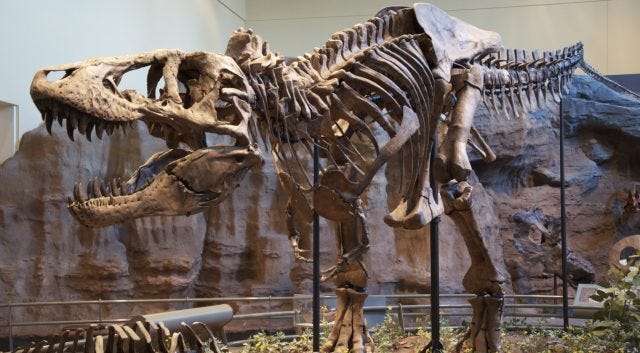Tyrannosaurus Rex: The Dinosaur with a Built-In Air Conditioner
Written on
Chapter 1: Understanding Dinosaur Fossils
Studying long-extinct species presents unique challenges, particularly due to the inadequate preservation of their soft tissues. Dinosaurs, widely recognized as some of the most fascinating creatures to have ever roamed the Earth, did not leave behind ample evidence for scientists to analyze. Instead of dying in optimal conditions for fossilization, they perished in various environments, complicating our understanding. Typically, fossilization captures only bone structures, with some faint imprints or traces indicating where soft tissues might have existed.
To investigate these ancient animals, paleontologists often rely on examining preserved bones and comparing them to contemporary species. By tracing the evolutionary lineage of modern animals back to their extinct counterparts, researchers can infer how certain features evolved and speculate on the function of ancient anatomical structures.
Section 1.1: The Air Conditioning System of T. rex
Recent studies focused on the skull of the Tyrannosaurus Rex suggest that these formidable creatures might have had a built-in cooling system within their skulls. In large animals, regulating body temperature is crucial, and various species have developed distinct adaptations to address this challenge. For instance, elephants utilize their large ears to release heat and can create cooling breezes by flapping them. Other large animals often inhabit water or remain active during cooler nighttime hours.
On the contrary, Tyrannosaurs possessed holes in their skulls known as dorsotemporal fenestrae. Historically, these openings were believed to primarily function as attachment points for massive jaw muscles. However, new findings published in The Anatomical Record propose that these fenestrae may have also served a significant role in thermoregulation. Researchers indicated:
[H]ere we present numerous lines of evidence which indicate that a sizable portion of the dorsotemporal fenestra in crocodylians, non-avian dinosaurs, and many other fossil archosaur lineages was not wholly muscular but instead likely housed vascular tissues.

Section 1.2: Evidence Supporting the Cooling Hypothesis
Several anatomical observations led scientists to this conclusion. For instance, the positioning of the holes suggests they would not serve well as muscle attachment points. Additionally, the smooth bone structure in this area contrasts with typical muscle attachment sites that are rough. To explore their hypothesis, researchers employed a FLIR camera to assess the body temperatures of alligators, particularly focusing on the dorsotemporal fenestrae. They discovered that these areas were significantly hotter in sunlight and cooler when shaded.
“One of the major physiological challenges that large animals have is being able to shed heat,” explained Casey Holliday, the study's lead researcher, in an interview with National Geographic. “If large theropod dinosaurs were warm-blooded, they likely faced similar heat dissipation challenges.”
Chapter 2: Additional Adaptations in Dinosaurs
Other dinosaur species, like ankylosaurs, exhibited intricate nasal passages filled with blood vessels to aid in heat dissipation. Unlike these dinosaurs, Tyrannosaurids lacked this feature, meaning they needed alternative methods to regulate their temperature. Releasing heat from the skull would be advantageous for protecting the brain from overheating. Furthermore, some dinosaurs had fenestrae near their neck frills, believed to be used for mating displays or signaling threats. It remains a possibility that T. rex or its relatives might have utilized blood vessels for color-changing displays, though this concept remains speculative.
The video titled "Even the King Needs AC || Tyrant Files" delves deeper into the fascinating adaptations of the T. rex, providing additional insights into how these ancient creatures may have regulated their body temperature.
Top image credit: Scott Robert Anselmo/Wikimedia Commons